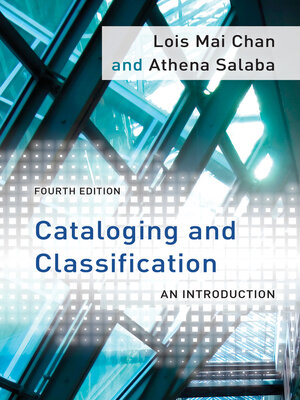
Sign up to save your library
With an OverDrive account, you can save your favorite libraries for at-a-glance information about availability. Find out more about OverDrive accounts.
Find this title in Libby, the library reading app by OverDrive.



Search for a digital library with this title
Title found at these libraries:
| Loading... |
The fourth edition of the late Lois Mai Chan's classic Cataloging and Classification covers the analysis and representation of methods used in describing, organizing, and providing access to resources made available in or through libraries. Since the last edition published in 2007, there have been dramatic changes in cataloging systems from the Library of Congress. The most notable being the shift from AACR2 to Resource Description and Access (RDA) as the new standard developed by the Library of Congress. With the help of the coauthor, Athena Salaba, this text is modified throughout to conform to the new standard.
Retaining the overall outline of the previous edition, this text presents the essence of library cataloging and classification in terms of three basic functions: descriptive cataloging, subject access, and classification. Within this framework, all chapters have been rewritten to incorporate the changes that have occurred during the interval between the third and fourth editions. In each part, the historical development and underlying principles of the retrieval mechanism at issue are treated first, because these are considered essential to an understanding of cataloging and classification. Discussion and examples of provisions in the standards and tools are then presented in order to illustrate the operations covered in each chapter.
Divided into five parts—a general overview; record production and structure, encoding formats, and metadata records; RDA; subject access and controlled vocabularies; and the organization of library resources—each part of the book begins with a list of the standards and tools used in the preparation and processing of that part of the cataloging record covered, followed by suggested background readings selected to help the reader gain an overview of the subject to be presented. This book is the standard text for the teaching and understanding of cataloging and classification.
Retaining the overall outline of the previous edition, this text presents the essence of library cataloging and classification in terms of three basic functions: descriptive cataloging, subject access, and classification. Within this framework, all chapters have been rewritten to incorporate the changes that have occurred during the interval between the third and fourth editions. In each part, the historical development and underlying principles of the retrieval mechanism at issue are treated first, because these are considered essential to an understanding of cataloging and classification. Discussion and examples of provisions in the standards and tools are then presented in order to illustrate the operations covered in each chapter.
Divided into five parts—a general overview; record production and structure, encoding formats, and metadata records; RDA; subject access and controlled vocabularies; and the organization of library resources—each part of the book begins with a list of the standards and tools used in the preparation and processing of that part of the cataloging record covered, followed by suggested background readings selected to help the reader gain an overview of the subject to be presented. This book is the standard text for the teaching and understanding of cataloging and classification.






